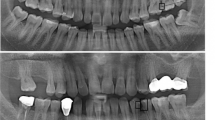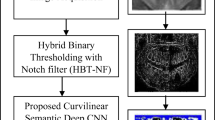Abstract
Proximal dental caries are diagnosed using dental X-ray images. Unfortunately, the diagnosis of proximal dental caries is often stifled due to the poor quality of dental X-ray images. Therefore, we propose an automatic detection system to detect proximal dental caries in periapical images for the first time. The system comprises four modules: horizontal alignment of pictured teeth, probability map generation, crown extraction, and refinement. We first align the pictured teeth horizontally as a pre-process to minimize performance degradation due to rotation. Next, a fully convolutional network are used to produce a caries probability map while crown regions are extracted based on optimization schemes and an edge-based level set method. In the refinement module, the caries probability map is refined by the distance probability modeled by crown regions since caries are located near tooth surfaces. Also we adopt non-maximum suppression to improve the detection performance. Experiments on various periapical images reveal that the proposed system using a convolutional neural network (CNN) and crown extraction is superior to the system using a naïve CNN.










Similar content being viewed by others
References
Long, J., Shelhamer, E., & Darrell, T. (2015). Fully convolutional networks for semantic segmentation. In IEEE Conference on Computer Vision and Pattern Recognition (pp. 3431–3440).
Li, C., Xu, C., Gui, C., & Fox, M.D. (2010). Distance regularized level set evolution and its application to image segmentation. IEEE Transactions on Image Processing, 19(12), 3243–3254.
Lowe, D.G. (2004). Distinctive image features from scale-invariant keypoints. International Journal of Computer Vision, 60(2), 91–110.
Dalal, N., & Triggs, B. (2005). Histograms of oriented gradients for human detection. In IEEE Conference on Computer Vision and Pattern Recognition (pp. 886–893).
Viola, P., & Jones, M. (2001). Rapid object detection using a boosted cascade of simple features. In IEEE Conference on Computer Vision and Pattern Recognition (pp. 511–518).
Ahonen, T., Hadid, A., & Pietikainen, M. (2006). Face description with local binary patterns: application to face recognition. IEEE Transactions on Pattern Analysis and Machine Intelligence, 28(12), 2037–2041.
Lecun, Y., Bengio, Y., & Hinton, G. (2015). Deep learning. Nature, 521(7553), 436–444.
Lecun, Y., Boser, B., Denker, J.S., Henderson, D., Howard, R.E., Habbard, W., & Jackel, L.D. (1990). Handwritten digit recognition with a back-propagation network. In Proceedings of Conference on Neural Information Processing Systems (pp. 396–404).
Boureau, Y.L., Ponce, J., & Lecun, Y. (2010). A theoretical analysis of feature pooling in visual recognition. In Proceedings of International Conference on Machine Learning (pp. 111–118).
Krizhevsky, A., Sutskever, I., & Hinton, G.E. (2012). Imagenet classification with deep convolutional neural networks. In Proceedings of Conference on Neural Information Processing Systems (pp. 1097–1105).
Lawrence, S., Giles, C.L., Tsoi, A.C., & Back, A.D. (1997). Face recognition: a convolutional neural-network approach. Proceedings of Conference on Neural Information Processing Systems, 8(1), 98–113.
Cireşan, D.C., Giusti, A., Gambardella, L.M., & Schmidhuber, J. (2013). Mitosis detection in breast cancer histology images with deep neural networks. In Proceedings of International Conference on Medical Image Computing and Computer-Assisted Intervention (pp. 411–418).
Zhang, W., Li, R., Deng, H., Wang, L., Lin, W., Ji, S., & Shen, D. (2015). Deep convolutional neural networks for multi-modality isointense infant brain image segmentation. NeuroImage, 214–224.
Cireşan, D.C., Giusti, A., Gambardella, L.M., & Schmidhuber, J. (2012). Deep neural networks segment neuronal membranes in electron microscopy images. In Proceedings of Conference on Neural Information Processing Systems (pp. 2843–2851).
Deng, J., Dong, W., Socher, R., Li, L.-J., Li, K., & Fei-Fei, L. (2009). Imagenet: A large-scale hierarchical image database. In Proceedings of IEEE Conference on Computer Vision and Pattern Recognition (pp. 248–255).
Taigman, Y., Yang, M., Ranzato, M.A., & Wolf, L. (2014). Deepface: Closing the gap to human-level performance in face verification. In Proceedings of IEEE Conference on Computer Vision and Pattern Recognition (pp. 1701–1708).
Jain, A.K., & Chen, H. (2004). Matching of dental X-ray images for human identification. Pattern Recognition, 37(7), 1519– 1532.
Fahmy, G., Nassar, D., Haj-Said, E., Chen, H., Nomir, O., Zhou, J., Howell, R., Ammar, H.H., Abdel-Mottaleb, M., & Jain, A.K. (2005). Toward an automated dental identification system. Journal of Electronic Imaging, 14(4), 043018.
Zhou, J., & Abdel-Mottaleb, M. (2005). A content-based system for human identification based on bitewing dental X-ray images. Pattern Recognition, 38(11), 2132–2142.
Nomir, O., & Abdel-Mottaleb, M. (2004). A system for human identification from X-ray dental radiographs. Pattern Recognition, 38(8), 1295–1305.
Mahoor, M.H., & Abdel-Mottaleb, M. (2005). Classification and numbering of teeth in dental bitewing images. Pattern Recognition, 38(4), 577–586.
Lin, P.L., Lai, Y.H., & Huang, P.W. (2010). An effective classification and numbering system for dental bitewing radiographs using teeth region and contour information. Pattern Recognition, 43(4), 1380–1392.
Kass, M., Witkin, A., & Terzopoulos, D. (1988). Snakes: Active contour models. International Journal of Computer Vision, 1(4), 321–331.
Al-sherif, N., Guo, G., & Ammar, H.H. (2012). A new approach to teeth segmentation. In Proceedings of IEEE International Symposium on Multimedia (pp. 1295–1305).
Avidan, S., & Shamir, A. (2007). Seam carving for content-aware image resizing. ACM Transactions on Graphics, 26(3), 10.
Shah, S., Abaza, A., Ross, A., & Ammar, H. (2006). Automatic tooth segmentation using active contour without edges. In Proceedings of Biometrics Symposium: Special Session on Research (pp. 1–6).
Chan, T.F., & Vese, L. (2001). Active contours without edges. IEEE Transactions on Image Processing, 10(2), 266–277.
Osher, S., & Sethian, J.A. (1988). Fronts propagating with curvature-dependent speed: Algorithms based on Hamilton- Jacobi formulations. Journal of Computational Physics, 79(1), 12–49.
Caselles, V., Catte, F., Coll, T., & Dibos, F. (1993). A geometric model for active contours in image processing. Numerische Mathematik, 66(1), 1–31.
Oliveira, J.P.R. (2009). Caries detection in panoramic dental X-ray images: Master Thesis, Universidade da Beira Interior Departamento de Informatica.
Rad, A.E., Amin, I.B.M., Rahim, M.S.M., & Kolivand, H. (2015). Computer-aided dental caries detection system from X-ray images. Computational Intelligence in Information Systems, 331, 233–243.
Otsu, N. (1979). A threshold selection method from gray-level histogram. IEEE Transactions on Systems, Man, and Cybernetics, 9(1), 62–66.
Fischler, M.A., & Bolles, R.C. (1981). Random sample consensus: A paradigm for model fitting with applications to image analysis and automated cartography. Communications of the ACM, 24(6), 381–395.
Nair, N., & Hinton, G.E. (2010). Rectified linear units improve restricted boltzmann machines. Inproceedings of International Conference on Machine Learning, 807–814.
Acknowledgments
This work is supported by Vatech Co., Ltd., Korea, for supporting the study and providing the dataset of dental X-ray images.
Author information
Authors and Affiliations
Corresponding author
Rights and permissions
About this article
Cite this article
Choi, J., Eun, H. & Kim, C. Boosting Proximal Dental Caries Detection via Combination of Variational Methods and Convolutional Neural Network. J Sign Process Syst 90, 87–97 (2018). https://doi.org/10.1007/s11265-016-1214-6
Received:
Revised:
Accepted:
Published:
Issue Date:
DOI: https://doi.org/10.1007/s11265-016-1214-6




